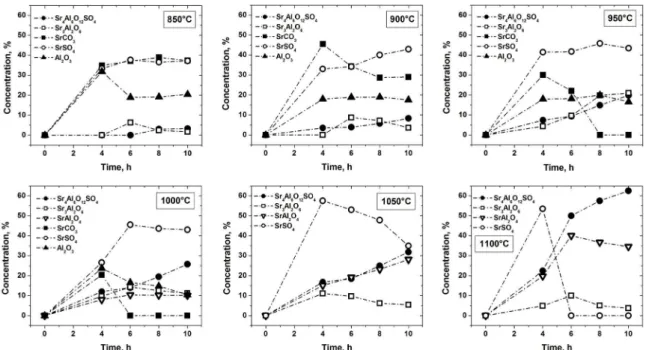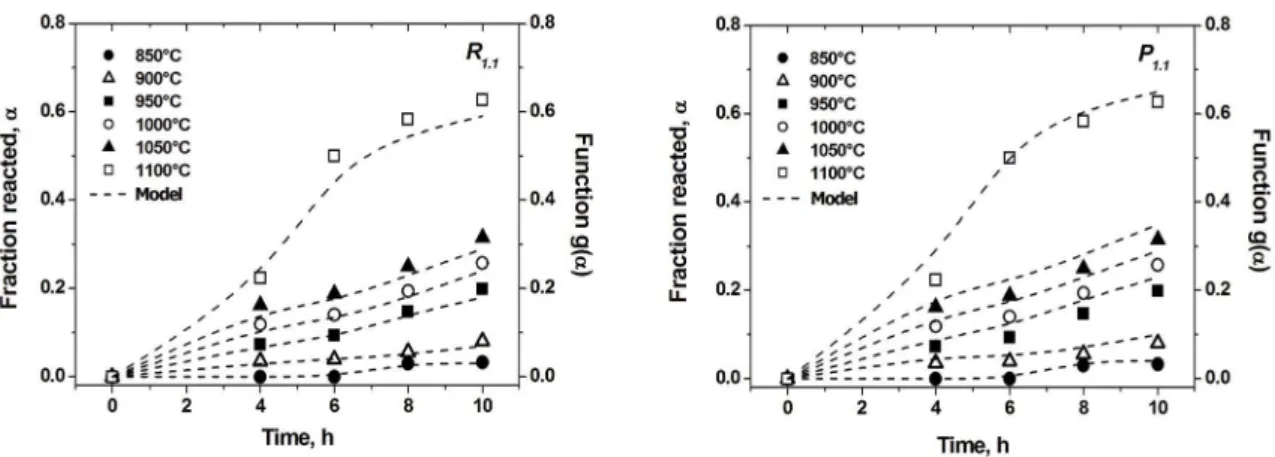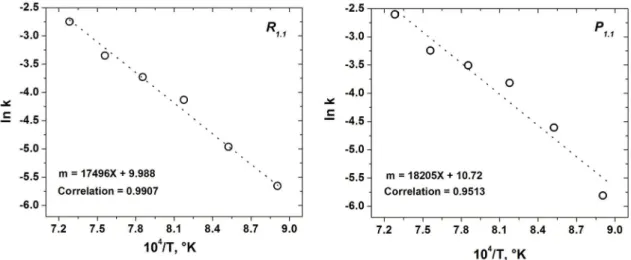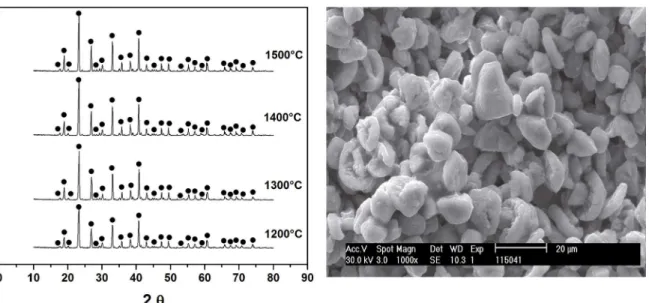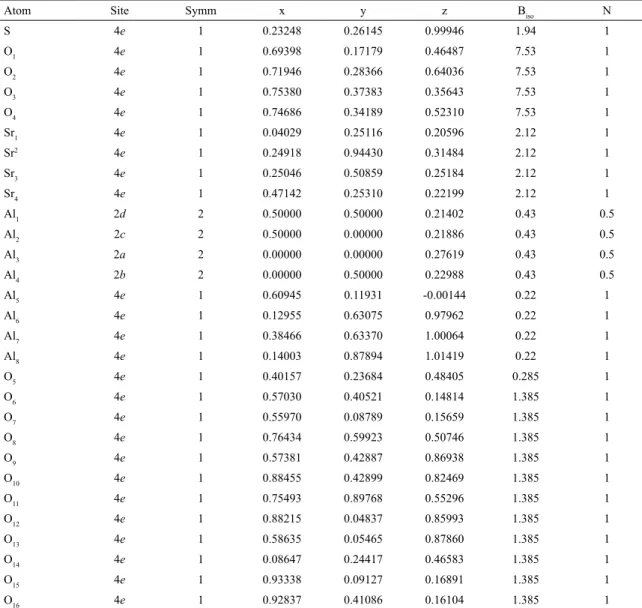Kinetics of Formation and Crystal Structure Determination of Sr
4Al
6O
12SO
4José Amparo Rodrígueza, Estrella Guadalupe Ríos Rodrígueza, Enrique Rocha Rangela*, José
Manuel Almanza Roblesb, Jesús Torresb, Elizabeth Refugio Garcíac
Received: September 03, 2016; Revised: November 28, 2016; Accepted: December 27, 2016
The sulphoaluminate of strontium, Sr4Al6O12SO4, was synthesized by solid state reaction from mixture of SrCO3, Al2O3 and SrSO4 (3:3:1 molar ratio) as pellets. The kinetics of formation has been studied in the range of temperature between 850°C and 1100°C using quantitative X–ray powder
difraction data (XRD) analysis. Likewise, at room temperature, the crystal structure was determined from conventional X–ray powder difraction data using direct methods and it was reined by the Rietveld method. The kinetics mechanisms that showed the best it, were identiied as geometrical
contraction at grain boundary (R1.1) and nucleation and growing by energy law (P1.1). The activation energy values obtained were 145.47KJmol-1 (R
1.1) and 151.35KJmol
-1 (P
1.1), respectively. The resulting
crystal structure was orthorhombic type (a: 13.32802Å, b: 13.34430Å and c: 9.38704Å). The observed adjustment parameters were RB: 0.0985, Rwp: 0.137, Rp: 0.0925 and Chi2: 1.94.
Keywords: Solid state reaction, Kinetic study, Crystal structure, Rietveld method
* e-mail: erochar@upv.edu.mx
1. Introduction
Reactions between solids are diverse, determinants being i) the thermodynamic conditions, ii) structural conditions and iii) reaction mechanisms governing the process. The Knowledge of the kinetic mechanisms that characterize a solid state reaction is essential for the control of a process, critical issue in the development of new products1. However, there are
few mathematical descriptions which provide suitable bases for prediction and interpretation of such reactions. On the other hand, knowledge of the crystal structure of any material is a fundamental requirement to understand and control the properties2.In recent decades they have seen a considerable
increase in the development of the structure determination
from powder difraction data3-5. An example is the Rietveld
method, computational program whose objective is the reining
of crystal structures using the technique of least squares by adjusting the patterns (experimental and calculated)2. Due
to the above and knowing that the information about the compounds formed within the system SrO–Al2O3–SrSO4 is low (only synthesis at high temperature, some physical and chemical properties of Sr4Al6O12SO4 were reported)6-10
as an integral part of the synthesis and characterization of strontium sulfoaluminate, Sr4Al6O12SO4, this paper presents i) the kinetic study of the formation from quantitative data
best it against kinetic models by solid state reaction and ii)
the crystal structure at room temperature through the reining of X-ray difraction patterns using the Rietveld method.
2. Experimental Procedure
The research was conducted in three stages; in the irst
stage the preparation and characterization of the samples are presented, in the second stage a study was performed to establish the kinetic of formation of Sr4Al6O12SO4 in the SrO–Al2O3–SrSO4 system and the third stage the crystal structure of the same strontium compound was determined.
2.1 Preparation and characterization of samples
Stoichiometric mixture of Al2O3, SrCO3 and SrSO4 (3:3:1 ratio molar) were accurately weighed and homogenized for 4 hours in plastic jar with acetone and alumina balls on spinning rolls. The mixtures was dried in a furnace at 100°C for 24 hours. After drying the mixture was ground in a mortar to disintegrate agglomerates. Disk pellets (20mm of diameter and 3mm thick), were made for each mixture by uniaxial pressing using at steel die. Press loading of 100MPa was used for all experiments. The samples were introduced into high alumina crucibles and were heat treated from 800 to 1400°C with isotherms of 4, 6, 8 and 10 hours, with a heating–cooling rate of 10°Cmin-1 and without the
use of a special gas to generate an enveloping atmosphere.
a Parque Cientíico y Tecnológico de Tamaulipas, Universidad Politécnica de Victoria, Avenida Nuevas
Tecnologías 5902, Ciudad Victoria, Tamaulipas, 87138, México
b Centro de Investigación y de Estudios Avanzados Unidad Saltillo, Industria Metalúrgica 1062, Parque
industrial Saltillo-Ramos Arizpe, Ramos Arizpe, Coahuila, 25900, México
c Departamento de Materiales, Universidad Autónoma Metropolitana, Avenida San Pablo 180, Colonia
To avoid possible chemical reactions between the samples and the crucibles, the dicks pellets were placed inside the crucible on a powder layer of the same stoichiometric mixture (previously described) and then covered with the same stoichiometric powder mixture before placing the alumina cap on the crucible. Subsequently, samples were
analyzed by X–ray powder difraction (XRD) and scanning
electron microscopy (SEM). The samples analyzed by SEM
(Philips XL30/ESEM) were cross sectioned and grinded
using SiC grinding media from 80 to 2400 grit size. Then the samples were polished using a 1µm diamond paste and treated to remove impurities in ultrasonic bath. Morphology of the phases present in each reaction step, were observed and semi-quantitative analysis (EDS) was performed. The samples analyzed by XRD, previously ground in a mortar
until a ine grain size was obtained (30gr). In this way,
randomly orientated samples were prepared to avoid preferred
orientation. The X-ray difractometer used (Philips TW–3040) with a monochromatic Cu–Kα radiation operating voltage
of 50KV and a current of 30mA. At room temperature, a
scanning speed of 0.10°2θmin-1 and a step size of 0.02° were
used to examine the samples in the range 10–80°2θ. The crystalline phases were identiied by means of the PAN-ICSD
database version 2013-1.
2.2 Kinetic study
Kinetic models governing the formation of Sr4Al6O12SO4 by solid state reaction in the SrO–Al2O3–SrSO4 system were determined. The main objectives of kinetic study were i) identifying the kinetic model(s) that describe the formation of
products and ii) determining the inluence of temperature on
the reaction rate. In both cases it was necessary to know the full extent of the reaction, that is, progressive changes from reactants to products in a given time. Such changes, known as reacted fraction1, were calculated by using Equation 1:
of the reaction, f(α) is the kinetic function and depends on the reaction mechanism, Ea is the activation energy for the reaction and R is the gas constant. If the reaction rate is constant, applying the logarithm and rearranging the equation:
( )
m
m
m
m
1
f t 0 0
a
=
-
-Were mo is the initial amount of product, mt is the amount of product at time t and mf is the inal amount of product. The
amounts of all the reaction products (strontium compounds) formed during the reactions steps were determined by
quantitative X–ray powder difraction data analysis, using
the Sietronics Traces 3.0 software and were plotted as
reacted fraction versus time. The basic equation that deines
the reaction rate is1:
( )
exp
t
A
RT
E
f
2
a2
2
a
a
=
T
-
Y
Q
V
Where α represents the reacted fraction (0 < α < 1) in
the solid reactant during the course of the reaction, A is the Arrhenius pre-exponential factor, T is the temperature
( )
ln
f
RT
E
aln
C
A
3
a
=
+
Q
V
S
X
Considering that the term ln (C/A) is constant, by
plotting f(α) against 1/T for various functions, it is possible to determine the kinetic model(s) describing the mechanism through which the reaction occurs, using the method of adjustment functions1. Namely, the experimental curves were
compared with ideal curves, these second obtained from the
introduction of fraction reacted values in diferent kinetics
models for solid state reaction reported in the literature, being determined kinetic model(s) have greater adjustment functions11. Kinetic phenomena were observed in the samples
analyzed by SEM in each reaction step.
2.3 Crystalline structure determination
The crystal structure of Sr4Al6O12SO4 was determined. The structure and microstructure features of the prepared
samples were obtained from X–ray powders difraction data
of the same heat treated at 1400°C with 4 hours isotherm. The measured angular range, the step size and counting times were selected to ensure enough resolution (the step
size should be at least, 1/10 of the fwhms) and statistics. The structural reinements were carried out by the Rietveld
method using the Fullprof program2; in some cases, a severe
microstructural contribution to the proile must be considered. The background intensities were itted to a polynomial
function with ten adjustable parameters. A phenomenological approach was applied using a capability of the program which allows some of the peaks to be described by their own breadths and shapes, as well as small displacements from their positions calculated from the average unit cell.
Prior to the structure reinements, a pattern matching without
structural model was performed. This procedure allows
obtaining suitable proile parameters, including the breadths, shapes and displacements of those relections with relevant
microstructural contributions. An overall isotropic thermal factor (ITF) was used for all the atoms in the structure. The
itting process was inished when convergence is reached.
3. Results and Discussion
3.1 Kinetic study
The kinetic of formation of strontium sulphoaluminate, Sr4Al6O12SO4, within the system SrO–Al2O3–SrSO4 was studied. Figure 1 shows the quantitative X–ray powder
Figure 1: Formation of strontium compounds and starting reagents, quantiied by X–ray powder difraction data for samples of the
3Al2O3:3SrCO3:SrSO4 mixture, heat treated at several temperatures and isotherms.
in the temperature range from 850 to 1100°C and diferent
isotherms.
As shown in Figure 1, as strontium compounds are produced the three starting reagents, SrCO3, SrSO4 and Al2O3, remaining quantity decreases, strontium sulfate only
remains to the inal stage of the reaction. With the process
of decomposition of the strontium carbonate in oxide (starts at low temperatures), results in the formation of strontium compounds. At all six temperatures studied, Sr4Al6O12SO4 was formed (result of the reaction between SrO, SrSO4 and Al2O3) and its amount increases gradually with increasing
temperature and time. Likewise, the presence of two strontium
aluminates, Sr3Al2O6 and SrAl2O4, as intermediate phases were formed (reaction between SrO and Al2O3) initially and persisted until the reaction to form Sr4Al6O12SO4 was nearly complete. Sr3Al2O6 was formed at 850°C, reached a maximum at 950°C with 10 hours isotherms and subsequently decreased. Meanwhile, SrAl2O4 was formed at 1000°C and its amount increases gradually with increasing temperature and time, reached a maximum at 1100°C with 6 hours isotherms. In the case of this type of aluminate (SrAl2O4), its formation has been previously explained: at temperatures lower than the transformation temperature of SrCO3 from orthorhombic to
hexagonal (<920°C), the formation of strontium compounds
is attributed to the interfacial reaction between SrCO3 and alumina. Conversely, at temperatures higher that 920°C,
the solid-state reaction is dominated by the difusion of Al+3
ions into the SrCO3 lattice12-13. At 1100°C these strontium
aluminates, Sr3Al2O6 and SrAl2O4, reacted with SrSO4 to form Sr4Al6O12SO4. To supplement the results, at 1150°C with 4
hours isotherm, the main identiied phase was Sr4Al6O12SO4.
This indicated that the formation of this compound is complete at 1150°C. The amount of Sr4Al6O12SO4 formed at several
temperatures is plotted as fraction reacted, α, as a function
of time in Figure 2.
This amount always increased with increase in temperature and the reaction approached completion at the highest temperatures. Shows the two models that had
the best it compared with the results. These two models
corresponded to R1.1 (geometrical contraction at grain boundary, 1 ‒ (1 ‒ α)1/n and P
1.1 (nucleation and growth by the energy law, α1/n). The value of “n” in both models was varied from 1 to 3 and the best it was found to be 1.1 for
each one. The kinetics study always gives an approximation of the phenomenon that is occurring; in this case both models can explain the kinetics formation of strontium compound Sr4Al6O12SO4. For the R1.1 model it can be observed that the
values of fraction formed did not it exactly with the model
for the curve at 1100°C. On the other hand for 1100°C the model P1.1, its accurately with experimental data. An analysis of Figure 1, can help to explain the inluence of both model in
the kinetics of Sr4Al6O12SO4 formation. At low temperatures 800 to 950°C, the amount of SrCO3 decreased considerably. This decreased in the amount of strontium carbonate indicates a rapid decomposition of SrCO3 in the sample volume, to form SrO available to react with Al2O3 and SrSO4 to form the strontium sulphoaluminate Sr4Al6O12SO4. This process presents a fast and dense initial nucleation at constant speed through all or some crystalline phases, due to the formation of interface reaction zones (low values fraction reacted),
with difusive efects and geometrical contraction. At high
Figure 2: Kinetics models it for the fraction formed of Sr4Al6O12SO4 as function of temperature and time.
(active interface) is increased, producing a greater number of nuclei in conjunction with the growth of these to form the total product volumer. Figure 3 shows micrographs of typical samples of 3Al2O3:3SrCO3:SrSO4 mixture, heat treated from 800 to 1150°C with 4h isotherm, to observe the kinetic mechanisms governing the formation of Sr4Al6O12SO4.
Figure 3: Micrographs of typical samples of 3Al2O3:3SrCO3:SrSO4 mixture, heat treated from 800 to 1150°C with 4h isotherm. A: 800°C, B: 900°C, C: 1000°C, D: 1100°C, E and F: 1150°C.
In Figure 3A nuclei of SrO (1) were identiied into
the volume of the sample at constant speed, with the dimensioning the crystal grain boundary. Porosity is also present due to the generation of CO2 and grains geometric
sufer contraction, as explained by the kinetic mechanism R1.1. In Figure 3C the strontium oxide reacts with alumina present in the system to give rise to two aluminates was observed, the SrAl2O4 (4) and Sr3Al2O6 (5) according to EDS analysis. The latter with a spherical morphology and both are reacting strontium sulfate, SrSO4 (3). In Figure 3D nucleation of Sr4Al6O12SO4 (6) was observed within particles corresponding to SrAl2O4 (4), according to the analysis of EDS, as explained by the kinetic mechanism
P1.1. The growth of these nuclei are shown in Figure 3E
where particles are identiied corresponding to Sr4Al6O12SO4
(6), according to the analysis of EDS and as explained by the kinetic mechanism P1.1. Figure 3F is a magniication
of a particle to observe the formation of agglomerates of microspheres for the Sr4Al6O12SO4 (6), according to the analysis of EDS. Figure 4 shows the curves of ln K
versus 1/T for both kinetic models. From this curves it was determined that the activation energy for the R1.1
and P1.1 models was 145.47KJmol-1 and 151.37KJmol-1,
respectively.
3.2 Crystal structure
Structural reinement process was divided into three
stages. Firstly, the size and shape of the unit cell was
determined through the reining of difraction patterns
with the Rietveld method (using the Fullproof program). Second, as it is a compound with unknown crystal system, the unit cell parameters such as; Miller indices and numbers of atoms were determined analytically14. Finally, the
positions of the atoms inside the unit cell were determined with the Rietveld method (using the Fullproof program). A prerequisite in order to begin with the structural determination
Figure 4: Activation energy curves for the two models involve in the formation of Sr4Al6O12SO4 strontium compound.
of any compound is the veriication of the purity of the sample. Figure 5 shows the X–ray difraction patterns for
samples heat treated from 1200 to 1500°C with 4 hours isotherm (the right side shows a typical SEM micrograph of Sr4Al6O12SO4 compound).
The stability of the compound is observed up to 1500°C since only the peaks corresponding to the Sr4Al6O12SO4, are
recorded without variation at intensities. Thus, the difraction
pattern employed for the structural determination was the heat treated at 1400°C with an isotherm of 4 hours. Recalling that the Fullprof program needs input crystallographic data
to begin reining, crystal system, space group and atomic
positions of the Ca4Al6O12SO4 were considered as initial variables15. Figure 6 shows the irst and last stage of itting of
the X-ray difraction patterns corresponding to Sr4Al6O12SO4
compound, where the evolutionary process of the method used is observed.
For the irst reining (6A) a value of convergence 105 was obtained. This is relected in the low it between the
experimental pattern (red spots) and the calculated pattern
(solid black line), relecting higher intensity peaks in the diferential curve (solid blue line). In the last stage of reining (6B) the value of Chi2 was of 1.94, relecting this
in the good it between experimental and calculated pattern and low intensity peaks in the diferential curve (Yobs - Ycal).
Considering the numbers of peak of the difraction pattern as well as the crystal system that is reining (Orthorhombic),
the results are acceptable. Figure 7 presents a scheme of the crystal structure of Sr4Al6O12SO4 strontium compound and crystallographic data.
Yellow spheres represent oxygen atoms (80), red spheres
Figure 5. On the left patterns of X-ray difraction of samples head treated at diferent temperatures with an isotherm of 4 hours. •:
Sr4Al6O12SO4. On the right shows a typical SEM micrograph of Sr4Al6O12SO4 compound.
Figure 6: First (A) and last (B) stage of reining difraction patterns, where the evolutionary process of the method used is observed.
Table 1. Atomic coordinates of elements present in the Sr4Al6O12SO4 compound.
Atom Site Symm x y z Biso N
S 4e 1 0.23248 0.26145 0.99946 1.94 1
O1 4e 1 0.69398 0.17179 0.46487 7.53 1
O2 4e 1 0.71946 0.28366 0.64036 7.53 1
O3 4e 1 0.75380 0.37383 0.35643 7.53 1
O4 4e 1 0.74686 0.34189 0.52310 7.53 1
Sr1 4e 1 0.04029 0.25116 0.20596 2.12 1
Sr2 4e 1 0.24918 0.94430 0.31484 2.12 1
Sr3 4e 1 0.25046 0.50859 0.25184 2.12 1
Sr4 4e 1 0.47142 0.25310 0.22199 2.12 1
Al1 2d 2 0.50000 0.50000 0.21402 0.43 0.5
Al2 2c 2 0.50000 0.00000 0.21886 0.43 0.5
Al3 2a 2 0.00000 0.00000 0.27619 0.43 0.5
Al4 2b 2 0.00000 0.50000 0.22988 0.43 0.5
Al5 4e 1 0.60945 0.11931 -0.00144 0.22 1
Al6 4e 1 0.12955 0.63075 0.97962 0.22 1
Al7 4e 1 0.38466 0.63370 1.00064 0.22 1
Al8 4e 1 0.14003 0.87894 1.01419 0.22 1
O5 4e 1 0.40157 0.23684 0.48405 0.285 1
O6 4e 1 0.57030 0.40521 0.14814 1.385 1
O7 4e 1 0.55970 0.08789 0.15659 1.385 1
O8 4e 1 0.76434 0.59923 0.50746 1.385 1
O9 4e 1 0.57381 0.42887 0.86938 1.385 1
O10 4e 1 0.88455 0.42899 0.82469 1.385 1
O11 4e 1 0.75493 0.89768 0.55296 1.385 1
O12 4e 1 0.88215 0.04837 0.85993 1.385 1
O13 4e 1 0.58635 0.05465 0.87860 1.385 1
O14 4e 1 0.08647 0.24417 0.46583 1.385 1
O15 4e 1 0.93338 0.09127 0.16891 1.385 1
O16 4e 1 0.92837 0.41086 0.16104 1.385 1
4. Conclusions
• The crystal structure of the Sr4Al6O12SO4 compound was determined using the Rietveld method. The shape of the unit cell is Orthorhombic, with next reticular parameters: a = 13.32802Å, b = 13.34430Å and c = 9.38704Å, the volume of cell is 1669.51414Å3 and
has Pcc2 space group. The number of atoms within the unit cell was determined, existing 80 atoms of oxygen, 30 atoms of aluminum, 20 atoms of strontium and 5 atoms of sulphur. The atomic positions within unit cell were determined using the Fullproof, FOX and CARINE computational programs.
• The kinetics of formation of Sr4Al6O12SO4 is controlled by two models, R1.1 (geometrical contraction at
grain boundary, 1 ‒ (1 ‒ α)1/n and P
1.1 (nucleation and growth by the energy law, α1/n). The activation
energies for these models were 145.47KJmol-1 and
151.37KJmol-1, respectively. It was identiied the
formation of Sr3Al2O6 and SrAl2O4 as intermediate phases. The formation of Sr4Al6O12SO4 occurred at low temperature as 1150°C.
5. Acknowledgments
Authors would like to thank to National Coucil of Science
and Technology of México (CONACyT) for inancial support
for the development of this work as well as the processing laboratories and characterization of CINVESTAV-Saltillo and UPV for the technical support.
6. References
del cloruro de bario dihidratado. Revista Cubana de Química. 2002;14(1):44-50.
2. Esteve Cano VJ, ed. El Método de Rietveld. 2ª ed. Castellón: Universitat Jaume I; 2014.
3. Harris KD, Tremayne M, Kariuki BM. Contemporary Advances in the Use of Powder X-Ray Diffraction for Structure Determination. Angewandte Chemie (International ed. in
English). 2001;40(9):1626-1651.
4. Tremayne M. The impact of powder difraction on the structural
characterization of organic crystalline materials. Philosophical
Transactions. Series A, Mathematical, Physical, and Engineering
Sciences. 2004;362(1825):2691-2707.
5. McCusker LB, von Dreele RB, Cox DE, Louër D, Scardi P. Rietveld reinement guidelines. Journal of Applied Crystallography. 1999;32:36-50.
6. Gilioli C, Massazza F, Pezzuoli M. A new compound: Strontium sulphoaluminate and its relationships with calcium sulphoaluminate. Cement and Concrete Research. 1971;1(6):621-629.
7. Brenchley ME, Weller MT. Synthesis and structure of sulide
aluminate sodalites. Journal of Materials Chemistry. 1992;2(10):1003-1005.
8. Rodríguez-García JA, Rocha-Rangel E, Torres-Torres J,
Almanza-Robles JM. Synthesis by a solid state reaction of the Sr4Al6O12SO4 compound. Journal of Ceramic Processing Research. 2011;12(3):310-313.
9. Rodríguez-García JA, Rocha-Rangel E, Almanza-Robles JM, Torres-Torres J, Leal Cruz AL, Munive GT. Chemical interaction of
Sr4Al6O12SO4 with liquid aluminum alloys. In: Sing JP, Bansal NP,
Goto T, Lamon J, Choi SR, Mahmoud MM, et al., eds. Processing and Properties of Advanced Ceramics and Composites IV: Ceramic Transactions, Volume 234. Hoboken: Willey; 2012. p. 21-27.
10. Rodríguez-García JA, Rocha-Rangel E, López Hernández J, Hernández-Bocanegra A, Leal-Cruz A, Almanza-Robles J, et
al. Physical properties of the Sr4Al6O12SO4 ceramic compound. Wulfenia Journal. 2014;21(2):420-427.
11. Brown ME, ed. Handbook of Thermal Analysis and Calorimetry. Amsterdam: Elsevier Science B.V.; 1998. 691 p.
12. Chang YL, Hsiang HI, Liang MT. Phase Evolution During
Formation of SrAl2O4 from SrCO3 and α-Al2O3/AlOOH. Journal
of the American Ceramic Society. 2007;90(9):2759-2765.
13. Rojas-Hernandez RE, Rubio-Marcos F, Gonçalves RH, Rodriguez MA, Véron E, Allix M, et al. Original Synthetic Route To Obtain a SrAl2O4 Phosphor by the Molten Salt Method: Insights into the Reaction Mechanism and Enhancement of the Persistent
Luminescence. Inorganic Chemistry. 2015;54(20):9896-9907.
14. Cullity BD. Elements of X-Ray Difraction. 2nd ed. Reading: Addison-Wesley; 1978.
15. Calos NJ, Kennard CHL, Whittaker AK, Davis RL. Structure of
